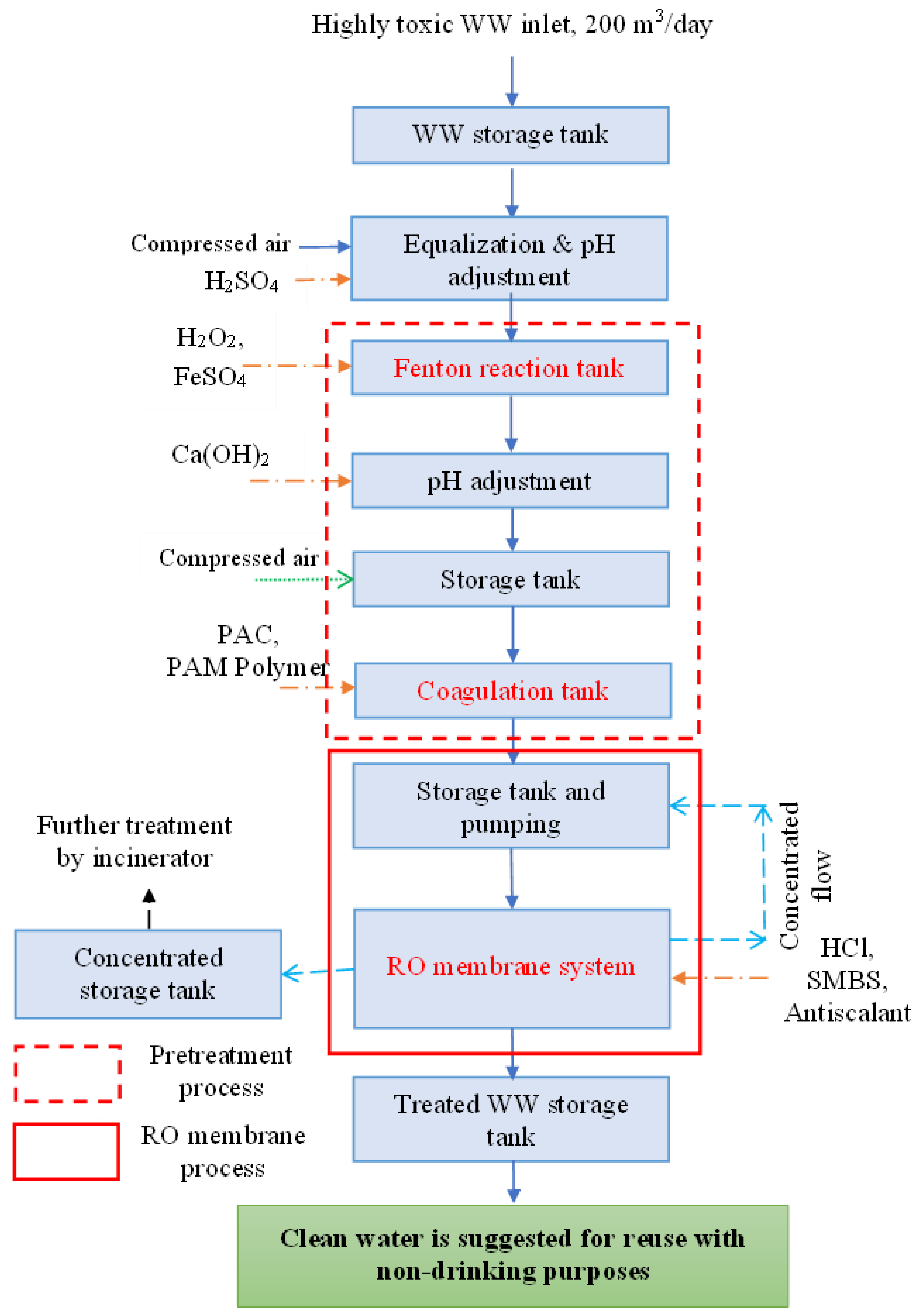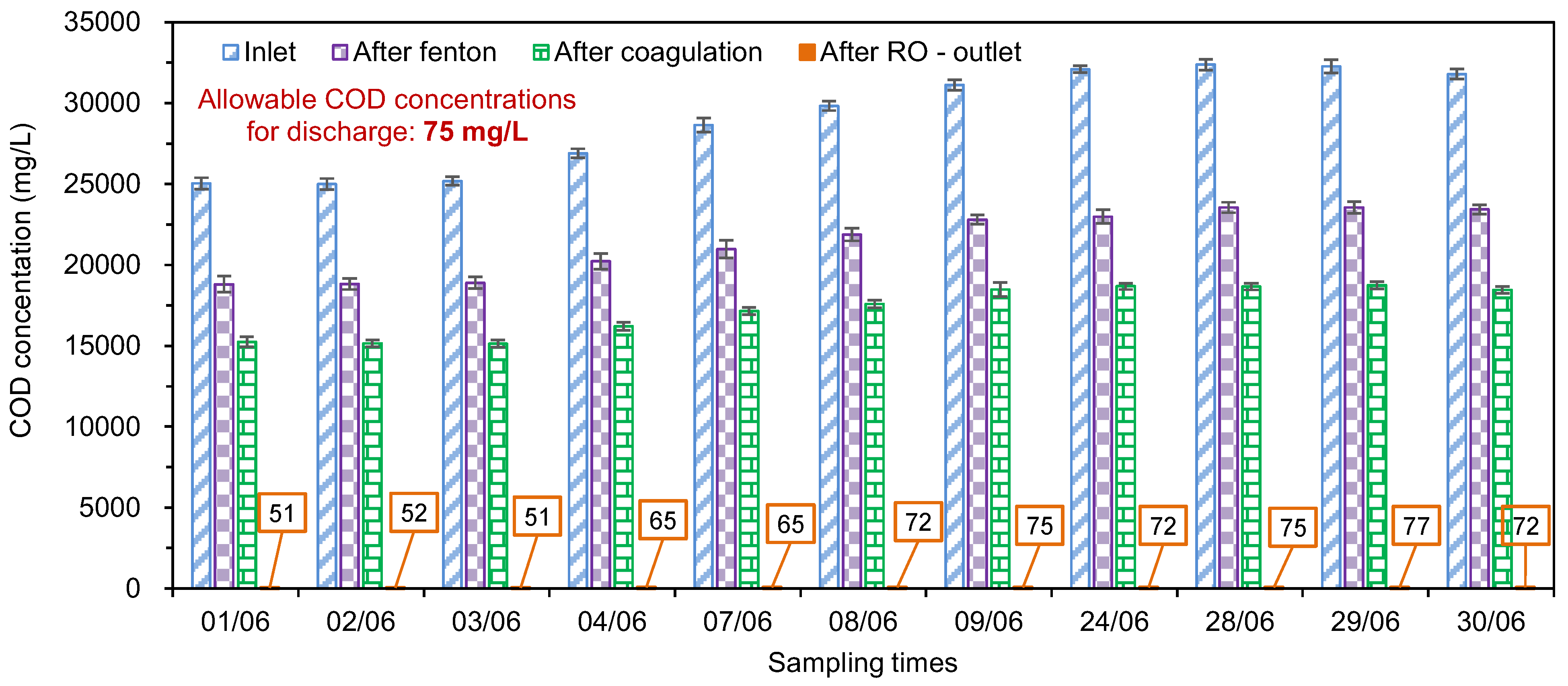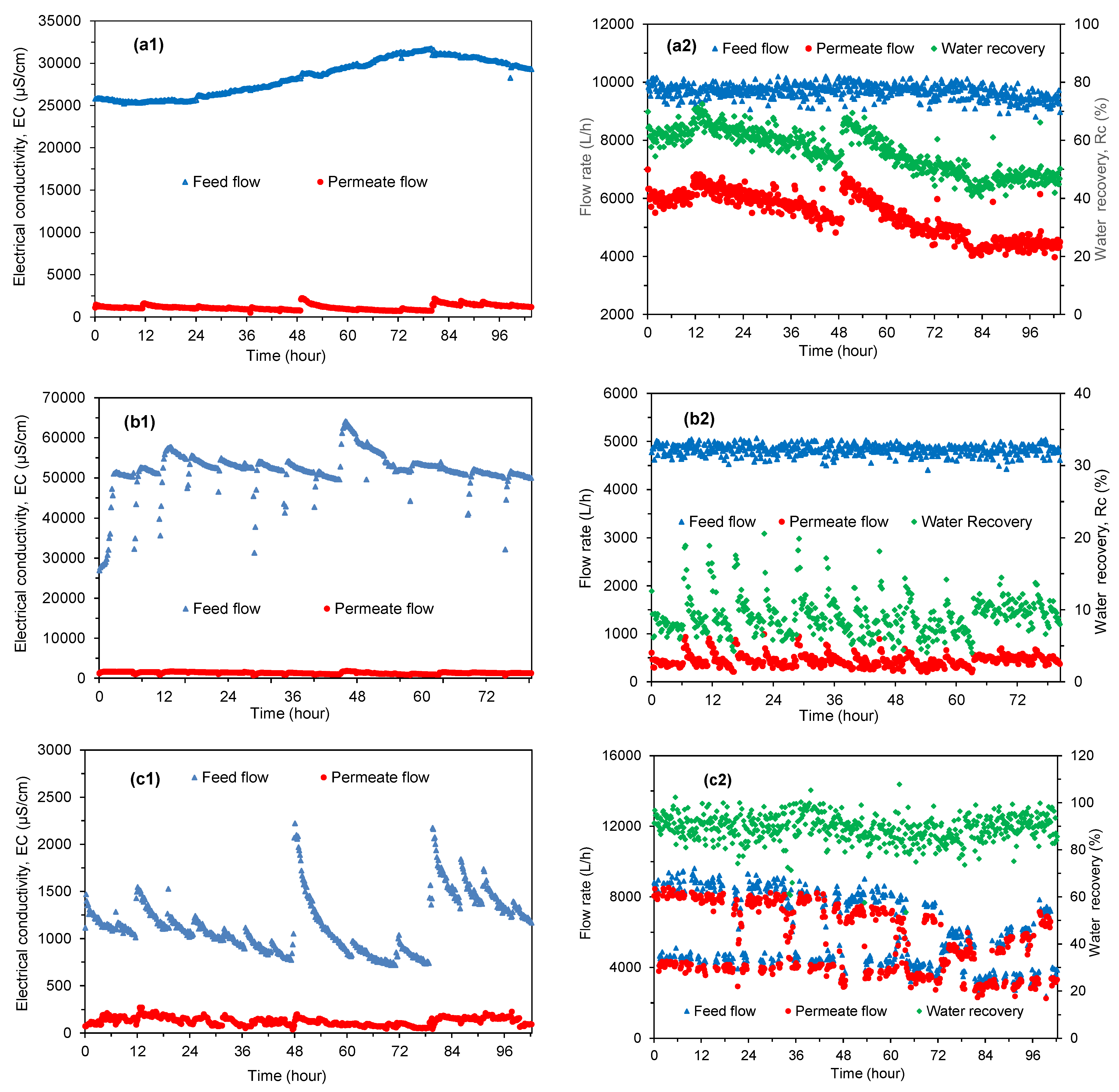Operation of Different Reverse Osmosis (RO) Membrane Modules for the Treatment of High-Strength Wastewater to Enhance the Recovery of Clean Water—A Case Study in Bac Ninh, Vietnam
Abstract
:1. Introduction
2. Materials and Methods
2.1. Wastewater Samples Characterization
2.2. Investigation of On-Site Operation at WWTP
2.3. Analytical Methods and Calculation
3. Results and Discussion
3.1. Performance of WWTP in Meeting the Current Discharge Standard
3.1.1. COD Removal Efficiency
3.1.2. Heavy Metals Removal Efficiency
3.1.3. Electrical Conductivity and Water Recovery
3.2. Comparison with Previous Studies
4. Conclusions
Future Perspectives
- -
- Further investigation on the collection, classification, and mixed ratio of different high-strength real wastewater sources should be carried out to determine the appropriate operational conditions since the properties of wastewater at the inlet are important in determining the optimum operational parameters.
- -
- Studies on pretreatment methods should be conducted to minimize the fouling and increase the performance of the RO system, which helps to achieve higher Rc
- -
- Future investigations should be consider methods to treat the concentrated flows from RO systems since the current treatment method (i.e., incineration) has high costs.
Author Contributions
Funding
Institutional Review Board Statement
Informed Consent Statement
Acknowledgments
Conflicts of Interest
References
- García-Martínez, J.B.; Sanchez-Tobos, L.P.; Carvajal-Albarracín, N.A.; Barajas-Solano, A.F.; Barajas-Ferreira, C.; Kafarov, V.; Zuorro, A. The Circular Economy Approach to Improving CNP Ratio in Inland Fishery Wastewater for Increasing Algal Biomass Production. Water 2022, 14, 749. [Google Scholar] [CrossRef]
- García-Martíneza, J.B.; Urbina-Suarezb, N.A.; Zuorroc, A.; Barajas-Solanob, A.F.; Kafarova, V. Fisheries wastewater as a sustainable media for the production of algae-based products. Chem. Eng. 2019, 76, 1339–1344. [Google Scholar]
- Liu, J. Aerobic Treatment of Effluents from the Electronics Industry. In Current Developments in Biotechnology and Bioengineering; Elsevier: Amsterdam, The Netherlands, 2017; pp. 145–160. [Google Scholar]
- Noor, I.-e.; Coenen, J.; Martin, A.; Dahl, O.; Åslin, M. Experimental investigation and techno-economic analysis of tetramethylammonium hydroxide removal from wastewater in nano-electronics manufacturing via membrane distillation. J. Membr. Sci. 2019, 579, 283–293. [Google Scholar] [CrossRef]
- Azimi, A.; Azari, A.; Rezakazemi, M.; Ansarpour, M. Removal of heavy metals from industrial wastewaters: A review. ChemBioEng Rev. 2017, 4, 37–59. [Google Scholar] [CrossRef]
- Sankhla, M.S.; Kumari, M.; Nandan, M.; Kumar, R.; Agrawal, P. Heavy metals contamination in water and their hazardous effect on human health-a review. Int. J. Curr. Microbiol. App. Sci. 2016, 5, 759–766. [Google Scholar] [CrossRef]
- Ahmed, M.B.; Zhou, J.L.; Ngo, H.H.; Guo, W.; Thomaidis, N.S.; Xu, J. Progress in the biological and chemical treatment technologies for emerging contaminant removal from wastewater: A critical review. J. Hazard. Mater. 2017, 323, 274–298. [Google Scholar] [CrossRef] [PubMed]
- Ma, W.; Ding, Y.; Li, Y.; Gao, S.; Jiang, Z.; Cui, J.; Huang, C.; Fu, G. Durable, self-healing superhydrophobic nanofibrous membrane with self-cleaning ability for highly-efficient oily wastewater purification. J. Membr. Sci. 2021, 634, 119402. [Google Scholar] [CrossRef]
- Aslam, M.; Charfi, A.; Lesage, G.; Heran, M.; Kim, J. Membrane bioreactors for wastewater treatment: A review of mechanical cleaning by scouring agents to control membrane fouling. Chem. Eng. J. 2017, 307, 897–913. [Google Scholar] [CrossRef]
- Deng, L.; Guo, W.; Ngo, H.H.; Zhang, H.; Wang, J.; Li, J.; Xia, S.; Wu, Y. Biofouling and control approaches in membrane bioreactors. Bioresour. Technol. 2016, 221, 656–665. [Google Scholar] [CrossRef] [PubMed]
- Obotey Ezugbe, E.; Rathilal, S. Membrane technologies in wastewater treatment: A review. Membranes 2020, 10, 89. [Google Scholar] [CrossRef] [PubMed]
- Trishitman, D.; Cassano, A.; Basile, A.; Rastogi, N.K. Reverse osmosis for industrial wastewater treatment. In Current Trends and Future Developments on (Bio-) Membranes; Elsevier: Amsterdam, The Netherlands, 2020; pp. 207–228. [Google Scholar]
- Deng, Y.; Zhao, R. Advanced oxidation processes (AOPs) in wastewater treatment. Curr. Pollut. Rep. 2015, 1, 167–176. [Google Scholar] [CrossRef]
- Vinh, L.X.; Phung, L.T.; Hien, T.T. Textile wastewater treatment by UV/Fenton process. Sci. Technol. Dev. J. 2015, 18, 201–211. [Google Scholar]
- Viet, L.H.; Binh, T.P.; Hau, M.T.; Ngan, N.V.C. Investigation of operating parameters of flocculation combined with fenton process for wastewater treatment of printing factories. Can Tho Univ. J. Sci. 2017, 162–172. [Google Scholar] [CrossRef]
- Baker, R.W. Membrane Technology and Applications; John Wiley & Sons: Hoboken, NJ, USA, 2012. [Google Scholar]
- Kucera, J. Desalination: Water from Water; John Wiley & Sons: Hoboken, NJ, USA, 2019. [Google Scholar]
- APHA. Standard Methods for the Examination of Water and Wastewater; American Public Health Association (APHA): Washington, DC, USA, 2005; Volume 21. [Google Scholar]
- Crittenden, J.C.; Trussell, R.R.; Hand, D.W.; Howe, K.J.; Tchobanoglous, G. MWH’s Water Treatment: Principles and Design; John Wiley & Sons: Hoboken, NJ, USA, 2012. [Google Scholar]
- Deng, Y.; Englehardt, J.D. Treatment of landfill leachate by the Fenton process. Water Res. 2006, 40, 3683–3694. [Google Scholar] [CrossRef] [PubMed]
- Ali, N.S.; Mo, K.; Kim, M. A case study on the relationship between conductivity and dissolved solids to evaluate the potential for reuse of reclaimed industrial wastewater. KSCE J. Civ. Eng. 2012, 16, 708–713. [Google Scholar] [CrossRef]
- Rusydi, A.F. Correlation between Conductivity and Total Dissolved Solid in Various Type of Water: A Review; IOP conference series: Earth and environmental science; IOP Publishing: Bristol, UK, 2018; p. 012019. [Google Scholar]
- Huang, X.-F.; Ling, J.; Xu, J.-C.; Feng, Y.; Li, G.-M. Advanced treatment of wastewater from an iron and steel enterprise by a constructed wetland/ultrafiltration/reverse osmosis process. Desalination 2011, 269, 41–49. [Google Scholar] [CrossRef]
- Abdel-Shafy, H.I.; El-Khateeb, M.A.; Mansour, M.S. Treatment of leather industrial wastewater via combined advanced oxidation and membrane filtration. Water Sci. Technol. 2016, 74, 586–594. [Google Scholar] [CrossRef] [PubMed]
- Bhattacharya, P.; Roy, A.; Sarkar, S.; Ghosh, S.; Majumdar, S.; Chakraborty, S.; Mandal, S.; Mukhopadhyay, A.; Bandyopadhyay, S. Combination technology of ceramic microfiltration and reverse osmosis for tannery wastewater recovery. Water Resour. Ind. 2013, 3, 48–62. [Google Scholar] [CrossRef] [Green Version]
- Zhang, Y.; Ma, C.; Ye, F.; Kong, Y.; Li, H. The treatment of wastewater of paper mill with integrated membrane process. Desalination 2009, 236, 349–356. [Google Scholar] [CrossRef]
- Duong, L.T.; Son, L.T. Performance evaluation of combined electro-fenton process and membrane bioreactor (MBR) for treating wastewater containing Glyphoaste herbicide. TNU J. Sci. Technol. 2019, 204, 211–217. [Google Scholar]





| No. | Parameters | Unit | Concentration of Wastewater before Treatment (*) | Water Quality Requirement after Treatment National Standard QCVN 40:2011/BTNMT (Level A) |
|---|---|---|---|---|
| 1 | pH | - | 3.5–9.5 | 6–9 |
| 2 | COD | mg/L | 23,707–37,333 | 75 |
| 3 | Chromium (VI) | mg/L | 1.6–3.2 | 0.05 |
| 4 | Copper (Cu) | mg/L | 372–532 | 2 |
| 5 | Zinc (Zn) | mg/L | 3.64–375.7 | 3 |
| 6 | Manganese (Mn) | mg/L | 11.19–36 | 0.5 |
| 7 | Iron (Fe) | mg/L | 113.6–460 | 1 |
| Treatment Method | Type of Wastewater | Technical Features of Operation | Performance (Removal Efficiency) | Ref. |
|---|---|---|---|---|
| UV + Fenton | Textile wastewater | H2O2 of 660 mg/L Fe2+ of 20 mg/L pH of 3.0 Reaction time of 90 min | Color of 94.5% COD of 95.5% No mention of water recovery | [14] |
| Coagulation + Fenton | Wastewater from printing factory | Coagulation: PAC of 150 mg/; CaCO3 of 67.5 mg/L Fenton: H2O2 of 100 mg/L; Fe2+ of 80 mg/L; and reaction time of 45 min | COD of 81.5%, COD of the output met the regulation as national standard QCVN 40:2011/BTNMT (level B). No mention of water recovery | [15] |
| CW (*) + UF + RO | Wastewater generated from an iron and steel factory | CW served as pretreatment; operation duration of 61 days | 77.3% COD; 76.9% NH4+; 95.8% turbidity; 96.9% Fe; and 92.5% Mn; RC = 75%; EC decreased to 10–30 μS/cm | [23] |
| AOP + MF | Effluent from leather industry | H2O2 and FeSO4 optimal dosages were pre-determined; MF membrane operated with aerated condition | 97.2% COD; 97.0% BOD5; 93.0% TSS; 87.4% oil and grease; 75% TKN; 40.8% TP. No mention of water recovery | [24] |
| MF + RO | Tannery wastewater | Dual-stage treatment; COD of 5680 mg/L; BOD5 759 mg/L | >90% BOD5, COD, TOC, NH4+, Cl−, SO42−; reuse of 50% wastewater after treatment | [25] |
| MBR + MF + RO | Wastewater from paper mill | Pilot scale | EC < 200 μS/cm, COD < 15 mg/L, Turbidity < 0.1 NTU; and Color < 15 PCU; RC > 65% | [26] |
| Electro-Fenton + MBR | Wastewater containing Glyphoaste herbicide | Electro-Fenton in 40 min and MBR in 24 h | The glyphosate concentration decreased from 29.5 mg/L to 0.3 mg/L COD, BOD5, ammonia after treatment: 32.6, 10.8, 0.76 mg/L | [27] |
| Fenton + Coagulation + RO with 3 different modules | Highly toxic wastewater collected from electronic and metal electroplating factories | Optimal conditions for Fenton and coagulation were experimentally determined; The membrane system included PFRO; HP PFRO; and SPRO | >99% COD, EC of permeate decreased to < 250 µS/cm; heavy metals concentration met the national discharge standard; average RC = 63% with PFRO; 9–12% with HP PFRO; and 80–90% with SPRO | This study |
Publisher’s Note: MDPI stays neutral with regard to jurisdictional claims in published maps and institutional affiliations. |
© 2022 by the authors. Licensee MDPI, Basel, Switzerland. This article is an open access article distributed under the terms and conditions of the Creative Commons Attribution (CC BY) license (https://creativecommons.org/licenses/by/4.0/).
Share and Cite
Ho, N.A.D.; Nguyen, V.H.; Babel, S. Operation of Different Reverse Osmosis (RO) Membrane Modules for the Treatment of High-Strength Wastewater to Enhance the Recovery of Clean Water—A Case Study in Bac Ninh, Vietnam. Sustainability 2022, 14, 16105. https://doi.org/10.3390/su142316105
Ho NAD, Nguyen VH, Babel S. Operation of Different Reverse Osmosis (RO) Membrane Modules for the Treatment of High-Strength Wastewater to Enhance the Recovery of Clean Water—A Case Study in Bac Ninh, Vietnam. Sustainability. 2022; 14(23):16105. https://doi.org/10.3390/su142316105
Chicago/Turabian StyleHo, Ngo Anh Dao, Van Hieu Nguyen, and Sandhya Babel. 2022. "Operation of Different Reverse Osmosis (RO) Membrane Modules for the Treatment of High-Strength Wastewater to Enhance the Recovery of Clean Water—A Case Study in Bac Ninh, Vietnam" Sustainability 14, no. 23: 16105. https://doi.org/10.3390/su142316105
APA StyleHo, N. A. D., Nguyen, V. H., & Babel, S. (2022). Operation of Different Reverse Osmosis (RO) Membrane Modules for the Treatment of High-Strength Wastewater to Enhance the Recovery of Clean Water—A Case Study in Bac Ninh, Vietnam. Sustainability, 14(23), 16105. https://doi.org/10.3390/su142316105







